In the fast-paced world of financial markets, understanding and interpreting market volatility is crucial for traders seeking to make informed investment decisions.
The utilization of technical indicators tailored to gauge volatility levels can be pivotal in navigating the complexities of fluctuating market conditions.
By exploring the intricacies of these indicators, traders can gain a competitive edge in identifying potential opportunities and managing risks effectively.
As we delve into the nuances of these seven key indicators for market volatility, a deeper insight into market dynamics and strategic decision-making awaits.
Average True Range (ATR) Indicator
The Average True Range (ATR) indicator, a widely used tool in financial markets, quantifies market volatility by averaging the price range between highs and lows over a specified timeframe. This indicator assists traders in assessing the degree of price movement within a market, offering valuable insights into potential price fluctuations.
By analyzing the ATR, traders can make informed decisions related to risk management and position sizing. A higher ATR value indicates greater volatility, suggesting larger price movements and potentially higher trading risks. Conversely, a lower ATR value signifies more stable price movements, indicating a period of lower volatility in the market.
Traders utilize the ATR to establish appropriate stop-loss levels and adjust their trading strategies according to the current market conditions. Understanding the Average True Range is crucial for traders seeking to adapt to changing price dynamics efficiently and make well-informed trading choices based on market volatility.
Volatility Index (VIX)
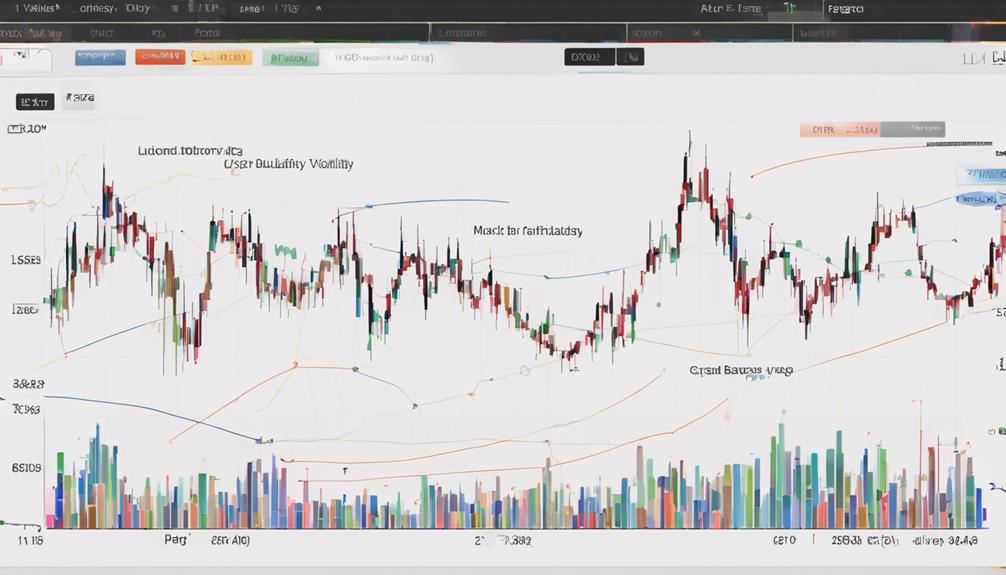
The Volatility Index (VIX) is a widely-used metric that offers insights into market sentiment through its calculation method and interpretation of VIX levels.
Understanding how the VIX is calculated and how different VIX levels are interpreted can provide traders with valuable information for developing effective trading strategies.
VIX Calculation Method
Calculated through a weighted average of S&P 500 Index option prices, the VIX, also known as the Volatility Index, provides insights into expected market volatility over the next 30 days.
- It measures implied volatility in the S&P 500 Index options, reflecting market expectations and risk perception.
- Values above 30 indicate heightened market volatility and the potential for significant price fluctuations.
- Investors use the VIX to gauge sentiment and anticipate market trends, particularly in uncertain or fearful periods.
- The VIX calculation method plays a crucial role in assessing risk levels and guiding decision-making based on expected market volatility.
Interpreting VIX Levels
Interpreting VIX levels provides traders with valuable insights into market sentiment and risk perceptions based on implied volatility in the S&P 500 Index options. VIX levels above 30 are indicative of heightened market volatility, as per the Cboe Volatility Index. This metric reflects the implied volatility in the S&P 500 for the upcoming 30 days, derived from options prices.
Traders utilize VIX levels to assess the prevailing fear or complacency within the market sentiment. Moreover, elevated VVIX values signal heightened uncertainty concerning short-term volatility in the Cboe VIX. Overall, VIX levels act as a real-time indicator of market expectations and risk perceptions, offering traders crucial information for navigating market dynamics.
VIX Trading Strategies
Utilizing VIX trading strategies, investors can effectively assess market sentiment, anticipate volatility, and refine risk management tactics based on implied volatility levels in the S&P 500 options market. When delving into VIX trading strategies, consider the following:
- 'Fear Index' Interpretation: Understanding the VIX as a measure of market expectations and sentiment.
- Volatility Assessment: Using VIX levels above 30 to signal potential market turmoil.
- Risk Management Adaptation: Adjusting strategies based on high or low VIX readings to manage risk effectively.
- Decision Making with Implied Volatility: Making informed investment choices during varying market sentiment scenarios.
These strategies can aid in navigating the complexities of market volatility and guide decision-making processes for investors.
Keltner Channel Indicator
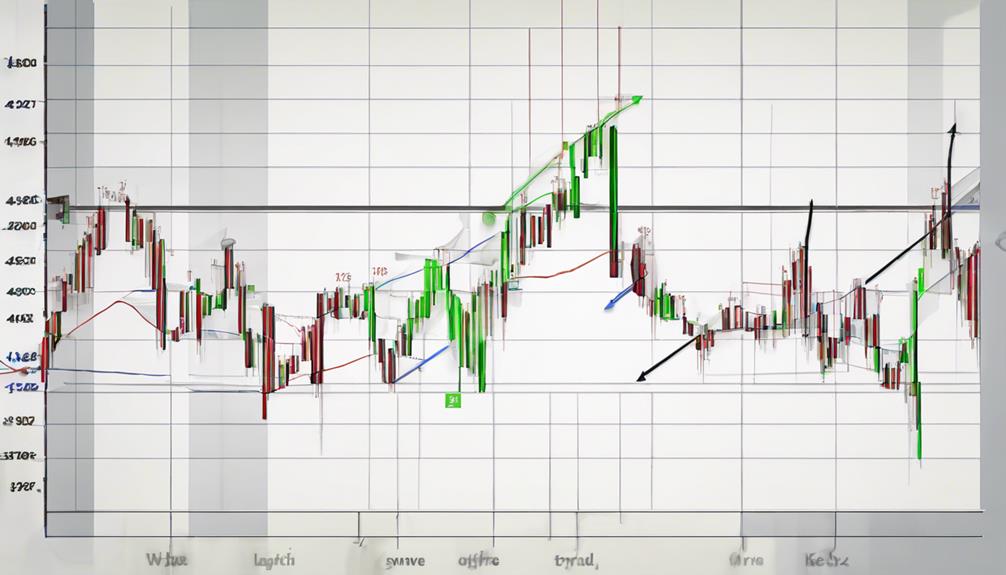
The Keltner Channel indicator provides traders with a structured framework for analyzing market volatility through the use of three key lines derived from the average true range (ATR).
By understanding the basics of the Keltner Channel, traders can set up parameters to effectively gauge volatility levels and interpret signal changes.
This indicator offers a practical tool for traders to make informed decisions regarding entry and exit points, as well as risk management strategies based on fluctuations in market volatility.
Keltner Channel Basics
An essential tool for assessing market volatility and potential price movements is the Keltner Channel indicator, which employs three key lines to analyze price volatility.
- The indicator utilizes an EMA, upper channel line, and lower channel line to determine volatility levels.
- It helps traders pinpoint trend reversals and continuation points by assessing volatility.
- The Keltner Channel is widely available on trading platforms, simplifying accessibility for traders.
- By measuring volatility in currency pairs, it aids in setting appropriate stop-loss and take-profit levels.
The Keltner Channel is a valuable instrument for evaluating market volatility and assisting traders in making well-informed decisions regarding their trading strategies.
Setting Up Parameters
When configuring the parameters for the Keltner Channel Indicator, traders can precisely tailor the settings to suit their analytical needs in assessing market volatility. The Keltner Channel Indicator uses an Exponential Moving Average (EMA) as its middle line, with upper and lower channel lines based on the Average True Range (ATR) to indicate potential price movements.
By adjusting these parameters, traders can effectively gauge market volatility, identify trends, and anticipate reversals. The Keltner Channel Indicator is readily available on various trading platforms, offering accessibility to traders seeking to make informed trading decisions based on volatility indicators.
Understanding how price movements interact with the upper and lower channel lines can provide valuable insights for traders navigating dynamic market conditions.
Interpreting Signal Changes
Interpreting signal changes in the Keltner Channel Indicator provides traders with crucial insights into evolving market volatility dynamics.
- Utilizing Average True Range (ATR): A key component in determining the Keltner Channel bands and reflecting market volatility levels.
- Monitoring Band Width Changes: Fluctuations in the width of the bands signal shifts in volatility, aiding in identifying potential trend reversals or breakouts.
- Identifying Entry/Exit Points: Traders can use band movements to pinpoint optimal times to enter or exit positions based on volatility levels.
- Enhancing Trend Analysis: Combining the Keltner Channel with other indicators offers a comprehensive view of market trends, empowering traders to make well-informed decisions.
Donchian Channel Indicator
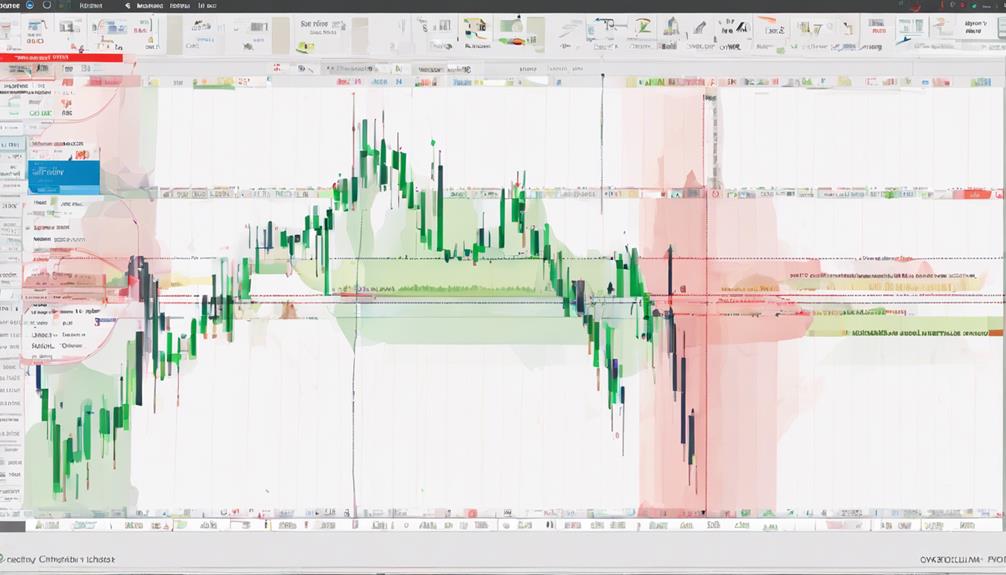
Efficiently capturing market volatility, the Donchian Channel Indicator, developed by Richard Donchian, strategically measures price fluctuations by plotting the highest high and lowest low over a specific time frame.
This indicator comprises three lines: the upper band indicating the highest high, the lower band representing the lowest low, and the middle band showing the average price.
Traders utilize the Donchian Channel to spot potential breakouts when prices breach the upper or lower bands. It aids in setting stop-loss orders by identifying support and resistance levels based on historical price extremes.
Particularly effective in trend-following strategies, Donchian Channels are valuable for recognizing price volatility and potential trend reversals. By incorporating this indicator into their analysis, traders can enhance their understanding of market dynamics and make more informed trading decisions based on historical price movements and current volatility levels.
Chaikin Volatility Indicator
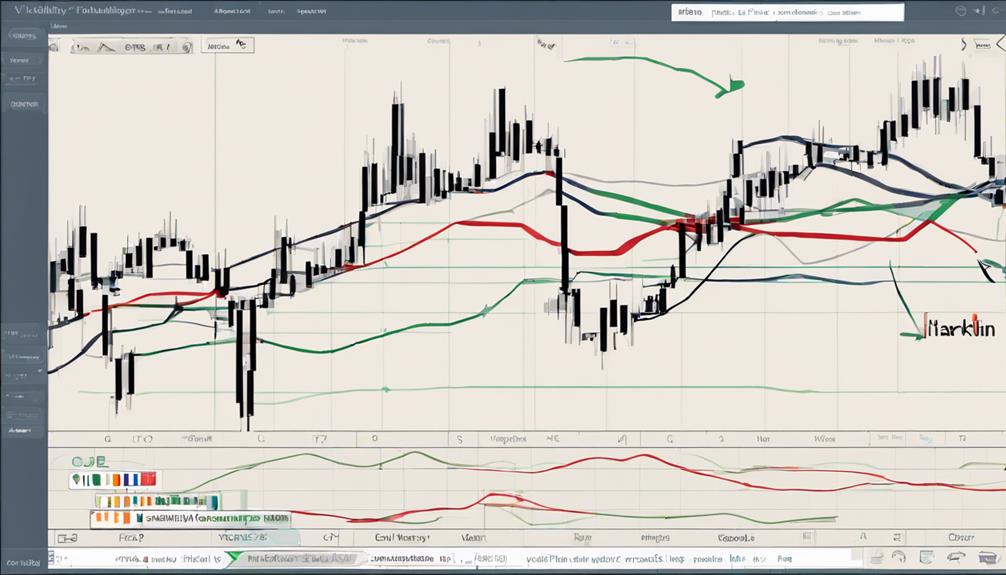
The Chaikin Volatility Indicator assesses market volatility by comparing high and low prices over a specific period, providing traders with valuable insights into price movements. When analyzing this technical analysis indicator, traders consider the following key points:
- Historical Volatility Calculation: The indicator calculates volatility based on the difference between high and low prices, offering a historical perspective on price fluctuations.
- Trading Ranges Emphasis: Emphasizing price range, the Chaikin Volatility Indicator helps traders understand the extent of price movements within a given period.
- Market Condition Assessment: Traders utilize the indicator to gauge market conditions, distinguishing between high volatility and low volatility phases to adapt their strategies accordingly.
- ATR Comparison: Traders often compare the Chaikin Volatility Indicator with the Average True Range (ATR) to validate volatility levels and confirm trading decisions.
Twiggs Volatility Indicator
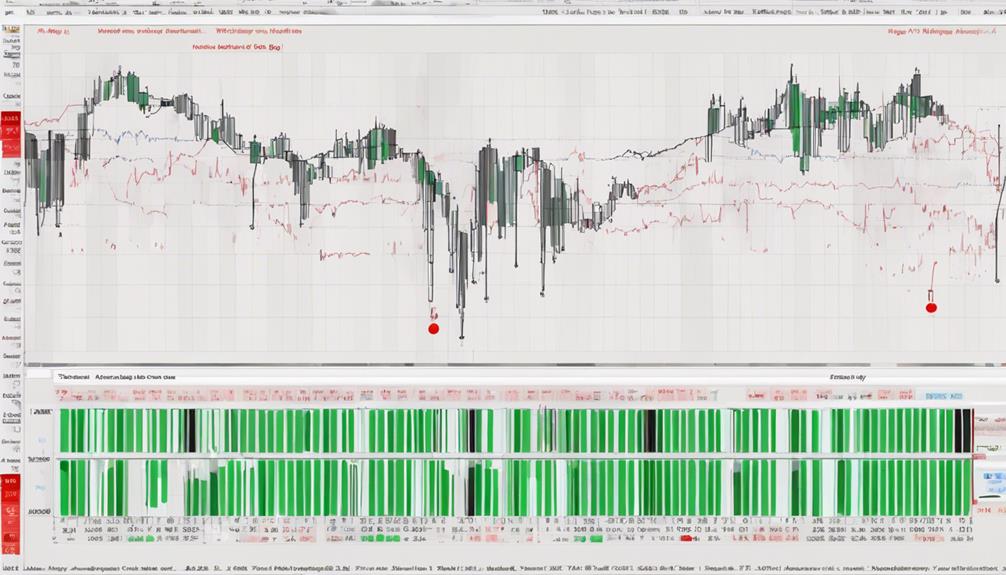
Utilizing a unique approach to measuring price volatility, the Twiggs Volatility Indicator serves as a valuable tool for traders seeking insights into market risk changes.
By calculating volatility through the true range and a multiplier factor for smoothing, this indicator helps identify potential shifts in market conditions. Traders can use the Twiggs Volatility Indicator to assess market risk levels effectively.
This assessment enables them to adjust their trading strategies in response to changing market dynamics. Moreover, the indicator aids traders in gauging the intensity of price movements, allowing them to anticipate market trends with greater precision.
By incorporating the Twiggs Volatility Indicator into their analytical toolkit, traders can make more informed decisions and adapt their strategies to suit the evolving market environment.
This proactive approach to risk management and trend anticipation can significantly enhance trading outcomes and overall performance.
Relative Volatility Index (RVI)
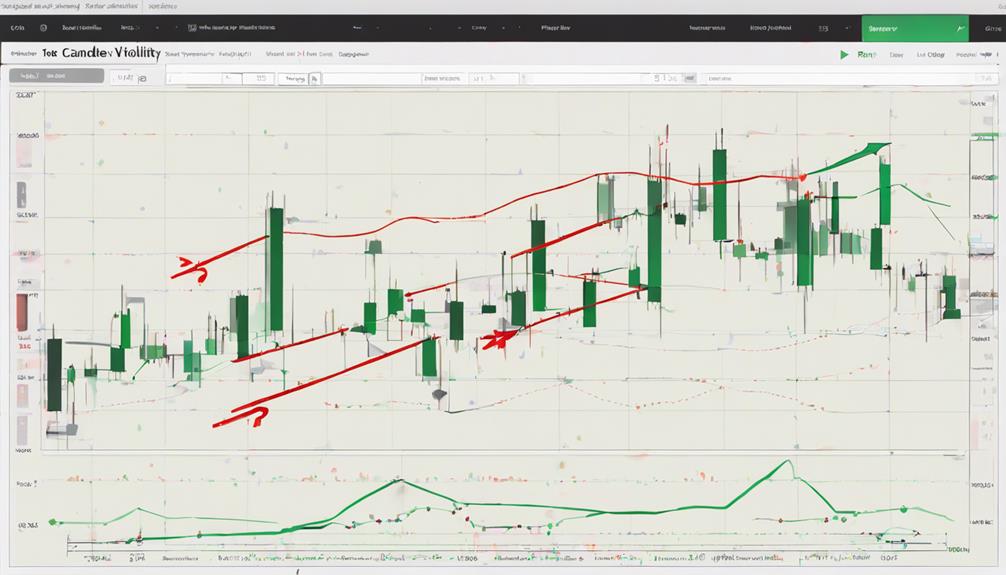
How does the Relative Volatility Index (RVI) serve as a key tool for measuring financial instrument volatility? The RVI is a valuable indicator for assessing market volatility as it compares the strength of a security's up moves to its down moves over a specific period.
Here are some key points about the RVI:
- Measurement of Volatility: The RVI is designed to measure the volatility of a financial instrument by analyzing the relationship between upward and downward price movements.
- Oscillation Range: RVI oscillates between 0 and 100. Values above 50 typically indicate increasing volatility in the market.
- Confirmation of Trends: Traders use the RVI to confirm the strength of a trend, helping them anticipate potential market reversals based on volatility expectations.
- Complement to ATR: The RVI can be used in conjunction with the Average True Range (ATR) indicator to gain a comprehensive understanding of volatility dynamics and make more informed trading decisions.
How Can I Use Technical Indicators for Market Volatility in Cryptocurrency Trading?
When it comes to cryptocurrency trading, utilizing the best cryptocurrency volatility indicators is crucial for assessing market volatility. Technical indicators, such as Bollinger Bands, Average True Range (ATR), and On-Balance Volume (OBV), can help traders identify volatility and make more informed trading decisions in the cryptocurrency market.
Frequently Asked Questions
Which Indicator Is Best for Volatility?
When evaluating which indicator is best for volatility, traders should consider the specific market conditions, trading strategy, and risk tolerance. Each indicator offers unique insights into market dynamics, helping traders make informed decisions based on current volatility levels.
What Is the Best Measure of Market Volatility?
Market volatility's best measure lies in the Volatility Index (VIX), a key indicator reflecting S&P 500 options' implied volatility. Traders keenly monitor VIX for real-time insights into market sentiment, adapting strategies based on prevailing fear or complacency levels.
Is VIX the Best Indicator of Market Volatility?
The VIX serves as a crucial market volatility indicator due to its reliance on S&P 500 options prices. While it provides valuable insights into implied volatility and market sentiment, traders may also utilize other technical indicators to enhance their volatility assessment strategies.
What Is the Best Volatility Indicator in Tradingview?
When considering the best volatility indicator in Tradingview, it is essential to evaluate factors such as accuracy, ease of interpretation, and versatility in various market conditions. One must assess the indicator's historical performance and adaptability to current trading strategies.
Conclusion
In conclusion, the 7 best technical indicators for market volatility serve as valuable tools for traders seeking to navigate fluctuations in the financial markets.
Like a compass guiding a ship through turbulent waters, these indicators offer insights into market dynamics and help investors make informed decisions.
By incorporating these indicators into their trading strategies, individuals can better anticipate and capitalize on shifts in volatility levels, ultimately enhancing their overall decision-making processes.
